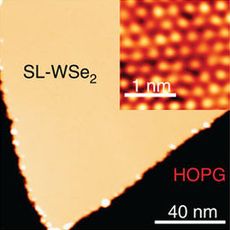セレン化タングステン(IV)
| セレン化タングステン(IV) | |
|---|---|
 グラフェン上の単層(黄色)とその原子像(枠内)[1]
| |

| |
| 識別情報 | |
| CAS登録番号 | 12067-46-8 |
| PubChem | 82910 |
| EC番号 | 235-078-7 |
| |
| |
| 特性 | |
| 化学式 | WSe2 |
| モル質量 | 341.76 g/mol |
| 外観 | 灰色から黒色の固体 |
| 匂い | 無臭 |
| 密度 | 9.32 g/cm3[4] |
| 融点 |
> 1200℃ |
| 水への溶解度 | 不溶 |
| バンドギャップ | ~1 eV (間接、バルク)[2] ~1.7 eV (直接、単層)[3] |
| 構造 | |
| 結晶構造 | hP6, 空間群 P63/mmc, No 194[4] |
| 格子定数 (a, b, c) | a = 0.3297 nm Å |
| 配位構造 | 三角柱形分子構造 (WIV) 四角錐形分子構造 (Se2-) |
| 熱化学 | |
| 標準生成熱 ΔfH |
-185.3 kJ mol-1[5] |
| 危険性 | |
| 主な危険性 | External MSDS |
| 関連する物質 | |
| その他の陰イオン | セレン化タンタル(IV) |
| 特記なき場合、データは常温 (25 °C)・常圧 (100 kPa) におけるものである。 | |
セレン化タングステン(IV)(Tungsten diselenide)は、化学式WSe2の無機化合物である[6]。硫化モリブデン(IV)と似た六方晶構造である。全てのタングステン原子は、三角柱形分子構造で6つのセレン配位子に共有結合し、各々のセレン原子は四角錐形分子構造で3つのタングステン原子と結合している。タングステン-セレン結合の結合長は0.2526 nmであり、セレン原子間の距離は0.334 nmである[7]。よく研究されている層状物質であり、層はファンデルワールス力により積み重なっている。第4属遷移金属ジカルコゲン化物の中では非常に安定な半導体である。
構造と性質[編集]
六方晶の(P63/mmc)多形2H-WSe2は、硫化モリブデン(IV)と同形である。二次元格子構造は、タングステン原子とセレン原子が層の中に六方対称で周期的に破裂している。グラファイトと同様、ファンデルワールス相互作用が層を保持しているが、1原子分の厚さではない。タングステンカチオンが大きいため、分子の格子構造は、硫化モリブデン(IV)と比べてより変化しやすくなる[8]。
通常の半導体性を持つ六方晶構造に加え、金属性を持つ八面体分子構造である他の多形1T-WSe2も存在する。この形は、1つの層が繰り返す四方対称である。1T-WSe2の相は安定性が低く、2H-WSe2の相に遷移する[8][9]。フラーレン様の構造を取ることもできる。
合成[編集]
圧力下、800K以上の温度で、スパッタ蒸着法を用いて気体セレン中においてタングステンフィルムを加熱すると、正しい化学量論比で六方構造を取った結晶のフィルムが形成する[10]。
- W + 2 Se → WSe2
応用可能性[編集]

遷移金属ジカルコゲン化物は、太陽電池やフォトニクスへの応用が考えうる半導体である[12]。
バルクのセレン化タングステン(IV)は、温度依存-4.6×10-4eV/Kで光学バンドギャップ~1.35 eVを持つ[13]。この化合物の光電極は、酸性環境でも塩基性環境でも安定であり、光化学電池の材料の候補になりうる[14][15][16]。
半導体にはよくあることだが、単層の性質はバルク状態によって異なる。
機械的に剥離した単層は透明で、発光ダイオードの性質を持つ光起電材料となる[17]。
できた太陽電池は、入射光の95%を通過させ、残りの5%の10分の1を電力に変える[18][19]。
この材料は、隣接金属電極の電圧を陽から陰にすることで、p型からn型に変えることができ、これで作る装置に調整可能なバンドギャップを持たせることができる[20]。
出典[編集]
- ^ Chiu, Ming-Hui; Zhang, Chendong; Shiu, Hung-Wei; Chuu, Chih-Piao; Chen, Chang-Hsiao; Chang, Chih-Yuan S.; Chen, Chia-Hao; Chou, Mei-Yin et al. (2015). “Determination of band alignment in the single-layer MoS2/WSe2 heterojunction”. Nature Communications 6: 7666. arXiv:1406.5137. Bibcode: 2015NatCo...6.7666C. doi:10.1038/ncomms8666. PMC 4518320. PMID 26179885.
- ^ Prakash, Abhijith; Appenzeller, Joerg (2017-02-28). “Bandgap Extraction and Device Analysis of Ionic Liquid Gated WSe2 Schottky Barrier Transistors”. ACS Nano 11 (2): 1626-1632. doi:10.1021/acsnano.6b07360. ISSN 1936-0851. PMID 28191930.
- ^ Yun, Won Seok; Han, S. W.; Hong, Soon Cheol; Kim, In Gee; Lee, J. D. (2012). “Thickness and strain effects on electronic structures of transition metal dichalcogenides: 2H-MX2 semiconductors (M = Mo, W; X = S, Se, Te)”. Physical Review B 85 (3): 033305. Bibcode: 2012PhRvB..85c3305Y. doi:10.1103/PhysRevB.85.033305.
- ^ a b Agarwal, M. K.; Wani, P. A. (1979). “Growth conditions and crystal structure parameters of layer compounds in the series Mo1-xWxSe2”. Materials Research Bulletin 14 (6): 825-830. doi:10.1016/0025-5408(79)90144-2.
- ^ O'Hare, P.A.G.; Lewis, Brett M.; parkinson, B.A. (June 1988). “Standard molar enthalpy of formation by fluorine-combustion calorimetry of tungsten diselenide (WSe2). Thermodynamics of the high-temperature vaporization of WSe2. Revised value of the standard molar enthalpy of formation of molybdenite (MoS2)” (英語). The Journal of Chemical Thermodynamics 20 (6): 681-691. doi:10.1016/0021-9614(88)90019-5.
- ^ Holleman, A. F.; Wiberg, E. (2001), Inorganic Chemistry, San Diego: Academic Press, ISBN 0-12-352651-5
- ^ Schutte, W.J.; De Boer, J.L.; Jellinek, F. (1986). “Crystal Structures of Tungsten Disulfide and Diselenide”. Journal of Solid State Chemistry 70 (2): 207-209. Bibcode: 1987JSSCh..70..207S. doi:10.1016/0022-4596(87)90057-0.
- ^ a b Eftekhari, Ali (2017). “Tungsten dichalcogenides (WS 2 , WSe 2 , and WTe 2 ): materials chemistry and applications” (英語). Journal of Materials Chemistry A 5 (35): 18299-18325. doi:10.1039/C7TA04268J. ISSN 2050-7488.
- ^ Ma, Yuqiang; Liu, Bilu; Zhang, Anyi; Chen, Liang; Fathi, Mohammad; Shen, Chenfei; Abbas, Ahmad N.; Ge, Mingyuan et al. (2015-07-28). “Reversible Semiconducting-to-Metallic Phase Transition in Chemical Vapor Deposition Grown Monolayer WSe 2 and Applications for Devices” (英語). ACS Nano 9 (7): 7383-7391. doi:10.1021/acsnano.5b02399. ISSN 1936-0851. PMID 26125321.
- ^ Pouzet, J.; Bernede, J.C.; Khellil, A.; Essaidi, H.; Benhida, S. (1992). “Preparation and characterization of tungsten diselenide thin films”. Thin Solid Films 208 (2): 252-259. Bibcode: 1992TSF...208..252P. doi:10.1016/0040-6090(92)90652-R.
- ^ Lin, Y. C.; Bjorkman, T. R.; Komsa, H. P.; Teng, P. Y.; Yeh, C. H.; Huang, F. S.; Lin, K. H.; Jadczak, J. et al. (2015). “Three-fold rotational defects in two-dimensional transition metal dichalcogenides”. Nature Communications 6: 6736. Bibcode: 2015NatCo...6.6736L. doi:10.1038/ncomms7736. PMC 4396367. PMID 25832503.
- ^ Mak, Kin Fai; Shan, Jie (2016). “Photonics and optoelectronics of 2D semiconductor transition metal dichalcogenides”. Nature Photonics 10 (4): 216-226. Bibcode: 2016NaPho..10..216M. doi:10.1038/nphoton.2015.282.
- ^ Upadhyayula, L.C.; Loferski, J.J.; Wold, A.; Giriat, W.; Kershaw, R. (1968). “Semiconducting Properties of Single Crystals of n- and p-Type Tungsten Diselenide (WSe2)”. Journal of Applied Physics 39 (10): 353-358. Bibcode: 1968JAP....39.4736U. doi:10.1063/1.1655829.
- ^ Gobrecht, J.; Gerischer, H.; Tributsch, H. (1978). “Electrochemical Solar Cell Based on the d-Band Semiconductor Tungsten-Diselenide”. Berichte der Bunsengesellschaft fur physikalische Chemie 82 (12): 1331-1335. doi:10.1002/bbpc.19780821212.
- ^ Xia, Fengnian; Wang, Han; Xiao, Di; Dubey, Madan; Ramasubramaniam, Ashwin (2014). “Two-dimensional material nanophotonics”. Nature Photonics 8 (12): 899-907. arXiv:1410.3882. Bibcode: 2014NaPho...8..899X. doi:10.1038/nphoton.2014.271.
- ^ Zhang, Xin; Qiao, Xiao-Fen; Shi, Wei; Wu, Jiang-Bin; Jiang, De-Sheng; Tan, Ping-Heng (2015). “Phonon and Raman scattering of two-dimensional transition metal dichalcogenides from monolayer, multilayer to bulk material”. Chem. Soc. Rev. 44 (9): 2757-85. arXiv:1502.00701. Bibcode: 2015arXiv150200701Z. doi:10.1039/C4CS00282B. PMID 25679474.
- ^ Li, Hai; Wu, Jumiati; Yin, Zongyou; Zhang, Hua (2014). “Preparation and Applications of Mechanically Exfoliated Single-Layer and Multilayer MoS2 and WSe2 Nanosheets”. Accounts of Chemical Research 47 (4): 1067-1075. doi:10.1021/ar4002312. PMID 24697842.
- ^ “Tungsten diselenide shows potential for ultrathin, flexible, semi-transparent solar cells”. Gizmag.com (2014年3月11日). 2014年8月17日閲覧。
- ^ Florian Aigenr (10 March 2014). "Atomically thin solar cells" (Press release). Vienna University of Technology. 2014年8月18日閲覧。
- ^ Lee, Sung-Joon; Lin, Zhaoyang; Huang, Jin; Choi, Christopher; Chen, Peng; Liu, Yuan; Guo, Jian; Jia, Chuancheng et al. (2020). “Programmable devices based on reversible solid-state doping of two-dimensional semiconductors with superionic silver iodide”. Nature Electronics 3: 630-637. doi:10.1038/s41928-020-00472-x.
